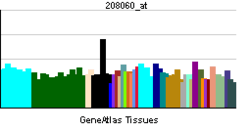PAX7
| View/Edit Human | View/Edit Mouse |
Paired box protein Pax-7 is a protein that in humans is encoded by the PAX7 gene.[4][5][6]
Function
Pax-7 plays a role in neural crest development and gastrulation, and it is an important factor in the expression of neural crest markers such as Slug, Sox9, Sox10 and HNK-1.[7] PAX7 is expressed in the palatal shelf of the maxilla, Meckel's cartilage, mesencephalon, nasal cavity, nasal epithelium, nasal capsule and pons.
Pax7 is a transcription factor that plays a role in myogenesis through regulation of muscle precursor cells proliferation. It can bind to DNA as an heterodimer with PAX3. Also interacts with PAXBP1; the interaction links PAX7 to a WDR5-containing histone methyltransferase complex By similarity. Interacts with DAXX too.[8]
Clinical significance
Pax proteins play critical roles during fetal development and cancer growth. The specific function of the paired box gene 7 is unknown but speculated to involve tumor suppression since fusion of this gene with a forkhead domain family member has been associated with alveolar rhabdomyosarcoma. Alternative splicing in this gene has produced two known products but the biological significance of the variants is unknown.[6] Animal studies show that mutant mice have malformation of maxilla and the nose.[9]
See also
References
- ↑ "Diseases that are genetically associated with PAX7 view/edit references on wikidata".
- ↑ "Human PubMed Reference:".
- ↑ "Mouse PubMed Reference:".
- ↑ Stapleton P, Weith A, Urbánek P, Kozmik Z, Busslinger M (Apr 1993). "Chromosomal localization of seven PAX genes and cloning of a novel family member, PAX-9". Nature Genetics. 3 (4): 292–8. doi:10.1038/ng0493-292. PMID 7981748.
- ↑ Pilz AJ, Povey S, Gruss P, Abbott CM (Mar 1993). "Mapping of the human homologs of the murine paired-box-containing genes". Mammalian Genome. 4 (2): 78–82. doi:10.1007/BF00290430. PMID 8431641.
- 1 2 "Entrez Gene: PAX7 paired box gene 7".
- ↑ Basch ML, Bronner-Fraser M, García-Castro MI (May 2006). "Specification of the neural crest occurs during gastrulation and requires Pax7". Nature. 441 (7090): 218–22. doi:10.1038/nature04684. PMID 16688176.
- ↑ http://www.uniprot.org/uniprot/P23759
- ↑ Mansouri A, Stoykova A, Torres M, Gruss P (Mar 1996). "Dysgenesis of cephalic neural crest derivatives in Pax7-/- mutant mice". Development. 122 (3): 831–8. PMID 8631261.
Further reading
- Blake J, Ziman MR (Apr 2003). "Aberrant PAX3 and PAX7 expression. A link to the metastatic potential of embryonal rhabdomyosarcoma and cutaneous malignant melanoma?". Histology and Histopathology. 18 (2): 529–39. PMID 12647804.
- Burri M, Tromvoukis Y, Bopp D, Frigerio G, Noll M (Apr 1989). "Conservation of the paired domain in metazoans and its structure in three isolated human genes". The EMBO Journal. 8 (4): 1183–90. PMC 400932
 . PMID 2501086.
. PMID 2501086. - Schäfer BW, Czerny T, Bernasconi M, Genini M, Busslinger M (Nov 1994). "Molecular cloning and characterization of a human PAX-7 cDNA expressed in normal and neoplastic myocytes". Nucleic Acids Research. 22 (22): 4574–82. doi:10.1093/nar/22.22.4574. PMC 308503
 . PMID 7527137.
. PMID 7527137. - Shapiro DN, Sublett JE, Li B, Valentine MB, Morris SW, Noll M (Sep 1993). "The gene for PAX7, a member of the paired-box-containing genes, is localized on human chromosome arm 1p36". Genomics. 17 (3): 767–9. doi:10.1006/geno.1993.1404. PMID 7902328.
- Cross SH, Charlton JA, Nan X, Bird AP (Mar 1994). "Purification of CpG islands using a methylated DNA binding column". Nature Genetics. 6 (3): 236–44. doi:10.1038/ng0394-236. PMID 8012384.
- Schäfer BW, Mattei MG (Jul 1993). "The human paired domain gene PAX7 (Hup1) maps to chromosome 1p35-1p36.2". Genomics. 17 (1): 249–51. doi:10.1006/geno.1993.1315. PMID 8104868.
- Barr FG, Nauta LE, Davis RJ, Schäfer BW, Nycum LM, Biegel JA (Jan 1996). "In vivo amplification of the PAX3-FKHR and PAX7-FKHR fusion genes in alveolar rhabdomyosarcoma". Human Molecular Genetics. 5 (1): 15–21. doi:10.1093/hmg/5.1.15. PMID 8789435.
- Vorobyov E, Mertsalov I, Dockhorn-Dworniczak B, Dworniczak B, Horst J (Oct 1997). "The genomic organization and the full coding region of the human PAX7 gene". Genomics. 45 (1): 168–74. doi:10.1006/geno.1997.4915. PMID 9339373.
- Magnaghi P, Roberts C, Lorain S, Lipinski M, Scambler PJ (Sep 1998). "HIRA, a mammalian homologue of Saccharomyces cerevisiae transcriptional co-repressors, interacts with Pax3". Nature Genetics. 20 (1): 74–7. doi:10.1038/1739. PMID 9731536.
- Margue CM, Bernasconi M, Barr FG, Schäfer BW (Jun 2000). "Transcriptional modulation of the anti-apoptotic protein BCL-XL by the paired box transcription factors PAX3 and PAX3/FKHR". Oncogene. 19 (25): 2921–9. doi:10.1038/sj.onc.1203607. PMID 10871843.
- Kondrashov AV, Pospelov VA (2002). "[In vitro modelling of the interactions between the promoter and enhancer complexes]". Tsitologiia. 43 (8): 764–71. PMID 11601392.
- Sorensen PH, Lynch JC, Qualman SJ, Tirabosco R, Lim JF, Maurer HM, Bridge JA, Crist WM, Triche TJ, Barr FG (Jun 2002). "PAX3-FKHR and PAX7-FKHR gene fusions are prognostic indicators in alveolar rhabdomyosarcoma: a report from the children's oncology group". Journal of Clinical Oncology. 20 (11): 2672–9. doi:10.1200/JCO.2002.03.137. PMID 12039929.
- Syagailo YV, Okladnova O, Reimer E, Grässle M, Mössner R, Gattenlöhner S, Marx A, Meyer J, Lesch KP (Jul 2002). "Structural and functional characterization of the human PAX7 5'-flanking regulatory region". Gene. 294 (1-2): 259–68. doi:10.1016/S0378-1119(02)00798-9. PMID 12234688.
- Tiffin N, Williams RD, Shipley J, Pritchard-Jones K (Jul 2003). "PAX7 expression in embryonal rhabdomyosarcoma suggests an origin in muscle satellite cells". British Journal of Cancer. 89 (2): 327–32. doi:10.1038/sj.bjc.6601040. PMC 2394255
 . PMID 12865925.
. PMID 12865925. - Tomescu O, Xia SJ, Strezlecki D, Bennicelli JL, Ginsberg J, Pawel B, Barr FG (Aug 2004). "Inducible short-term and stable long-term cell culture systems reveal that the PAX3-FKHR fusion oncoprotein regulates CXCR4, PAX3, and PAX7 expression". Laboratory Investigation. 84 (8): 1060–70. doi:10.1038/labinvest.3700125. PMID 15184910.
- Vorobyov E, Horst J (Nov 2004). "Expression of two protein isoforms of PAX7 is controlled by competing cleavage-polyadenylation and splicing". Gene. 342 (1): 107–12. doi:10.1016/j.gene.2004.07.030. PMID 15527970.
External links
- PAX7 protein, human at the US National Library of Medicine Medical Subject Headings (MeSH)
- PAX7 human gene location in the UCSC Genome Browser.
- PAX7 human gene details in the UCSC Genome Browser.
This article incorporates text from the United States National Library of Medicine, which is in the public domain.
